-
Posts
1,065 -
Joined
-
Last visited
-
Days Won
1
Content Type
Profiles
Forums
Blogs
Gallery
Events
Store
Posts posted by Graham Stewart
-
-
This is brief resume of the battalion he command, but sadly all of my notes regarding the battalion are in the UK. The battalion served alongside the 10th(Service)Bn, Northumberland Fusiliers in 68th Bde, 23rd Division, but neither battalion completed a War History during the post-war year. A history of 23rd Division was produced, but is extremely rare to get hold of, which contains many references to the battalions that served with it and the actions they took part in. Both battalion War Diaries also survive.
11th (Service) Battalion
Formed at Newcastle in September 1914 as part of Kitcheners 3rd New Army and attached to 68th Brigade, 23rd Division. Trained in Southern England before landing in France August 1915.
Moved to Italy with the Division in November 1917 after taking part in the Battle of Passchendaele.
Although I haven't got my notes here believe they were also at Loos in 1915 and then the Somme in 1916.
He must have been one hell of a C.O. and being given command of a British battalion during war time wasn't a matter to be taken likely by the War Office, so he must have had the right credentials for the battalion to be entrusted to him.
0 -

Sgt Major Morgan, 4th Bn, Northumberland Fusiliers, 1904 wearing the single crown of that rank. Note he also wears an officers pattern full dress tunic as denotes his rank.
0 -

The rank badge of the RQMS as it was - 4 inverted chevrons above which was a star. An RQMS Northumberland Fusiliers, 23rd April(St.Georges Day) - 1881-1902.
0 -

23rd April - St.George Day and a beautiful illustration of the RQMS of the Northumberland Fusiliers by Brian Fosten, clearly showing his badge of rank. This uniform was worn from 1881 through to c1902, when a new pointed cuff was adopted and facing colours were re-introduced for non-Royal regiments.
0 -

The rank of CSM for the infantry only dates back to the advent of the Great War as pointed out in the post regarding RSM's and the introduction of the four company organisation of battalions. Prior to that each battalion had eight Colour Sgts for the eight company's within a battalion. Their badge of rank on full dress was the crossed union flags with a crown above three chevrons. However no equivalent badge was produced for wear with SD, so a compromise was reached whereby a large crown was worn above three chevrons on the upper arm. Later this badge would be worn by those junior Clr Sgt's who became Company Quartermaster Sgt's. The four senior 'Colours' went onto become Company Sgt Majors who adopted the badge of the former 'Sgt Major' - a crown - on the lower left cuff.
0 -
The rank RSM for the regular infantry actually only appeared on the advent of the Great War, which is when the 'Royal Arms' badge was adopted prior to that the rank was simply 'Sergeant Major', the badge of rank being a large crown worn on the lower right cuff in both bullion with full dress or khaki worsted with SD. On the introduction of the rank 'RSM', in compliance with the introduction of the four company system, the eight Colour Sergeants within the infantry were also re-ranked - the four senior 'Colours' then became 'Company Sgt Majors', they adopted the crown of the former Sgt Major, but slightly smaller as their badge of rank. The four junior 'Colours' then became 'Company Quartermaster Sgt's'. Their badge of rank was the crown worn above the three sgt's stripes.
The Colour Sgt's had their own bullion badge of rank for full dress, which was the crossed union flags above which was a crown above three chevrons, but there was no equivalent for SD and a compromise was adopted where a large crown was worn above the three chevrons. As stated above this was to become the badge of the CQMS the restructuring of the infantry ranks.
The RQMS retained his rank and badge which was four inverted chevrons on the lower cuff above which was a small star.
The system gets even more complicated when looking at the rank and badges of those serving with the Volunteers/Territorials
0 -
No problem Louise. Unfortunately I no longer live in the UK or I could have done a bit more to help. I believe Newcastle Central Library has had a major refurbishment carried out, so I'm not sure if all of the local history stuff is still on the top floor. I used to spend hours in there copying the battalion war diaries from the microfiche. This how me and John Sheen were able to put the book together on the Tyneside Scottish.
0 -
As suspected the Cyclist Battalions, Royal Scots didn't serve in France & Flanders, but the 2/10th went to North Russia in 1918. I think the BWM & Victory Medals were only awarded for service in during the Great War and not North Russia, but if they were it would be a bonus for you. As he only has a six figure number on the medals and MIC he's a late enlistment as the six figure Territorial numbers weren't issued until 1917.
1/10th (Cyclist) Battalion
August 1914 : at Linlithgow. Army Troops not under command of a Brigade or defence area.
Moved to coastal defence at Berwick until April 1918, then to Ireland.
2/10th (Cyclist) Battalion
Formed in Linlithgow, September 1914.
Moved to coastal defence at Berwick until April 1918, then to Ireland.
Reorganised as an infantry battalion, the 2/10th moved to England in July 1918 and to North Russia in August 1918 as part of the Archangel Force, returning home June 1919.
0 -
Nice to see these medals have gone to a good home and will be appreciated. The lad in question was a Territorial and his number is attributed to the 10th(Cyclist)Bn, Royal Scots. I'm unsure if this battalion actually served overseas but will check other sources. However it's more than likely that if they didn't serve overseas he was transferred to another battallion.
0 -
Technically known as a "Torrin" cap, due to the curveture to the front & rear, your Alex Baker postcards show's the officer wearing one during the Korean War. I have one of these too, but what I haven't got is an officers Field Service cap to the NF in dark blue. The bullion cap badge worn with the Torrin is basically the collar badge off the officers mess dress, where the grenade is vertical on the lapel. NF officer's full dress collars are twice this size and as you say the 'bomb' is horizontal to St.George.
0 -
Hi Leigh - sadly the "Van Dyked(Hounds tooth)" rim which would adorn the drum top and bottom had been removed and a piece of ply-wood nailed across the rear. It must have hung on a wall as it had a bit of picture cord and picture screws also at the rear.
0 -
Hi Mervyn,
Certainly did and a lovely peice it is too. Actually looking at your drum reminded me that I had this wrapped up in the loft.
0 -

A close up of the beautifully hand painted centre section - no transfers them days lads.
0 -
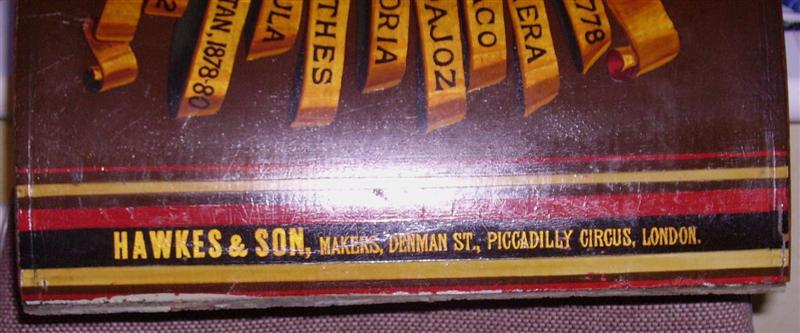
The makers mark "Hawkes & Son", Makers, Denmark St., Piccadilly Circus, London. Within the drum shell and not photographed is also a makers label.
0 -
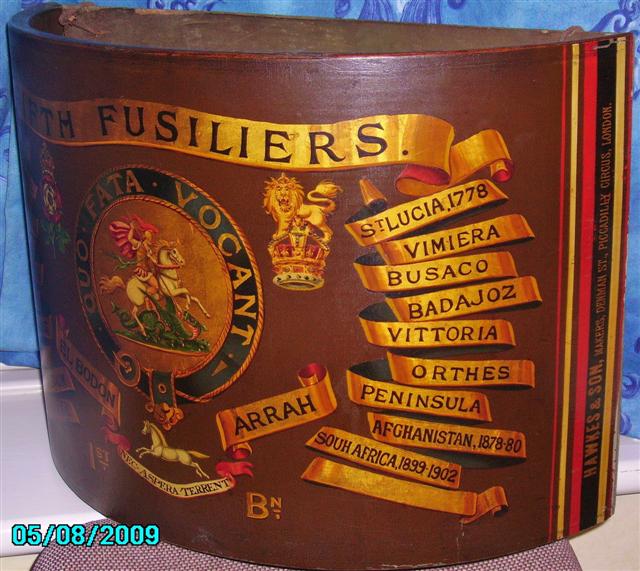
The Battle Honours to the left - note the blank scroll to even out the honours either side.
0 -
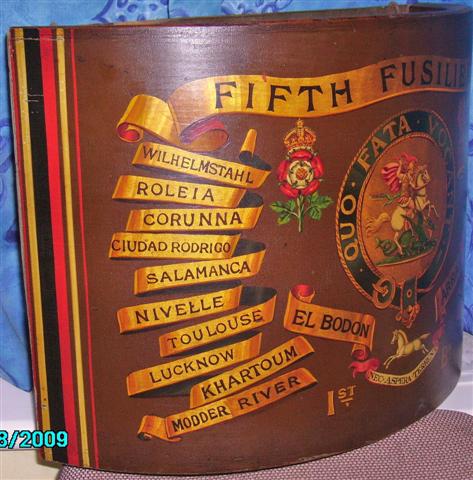
The regiments Battle Honours to the right of the drum.
0 -
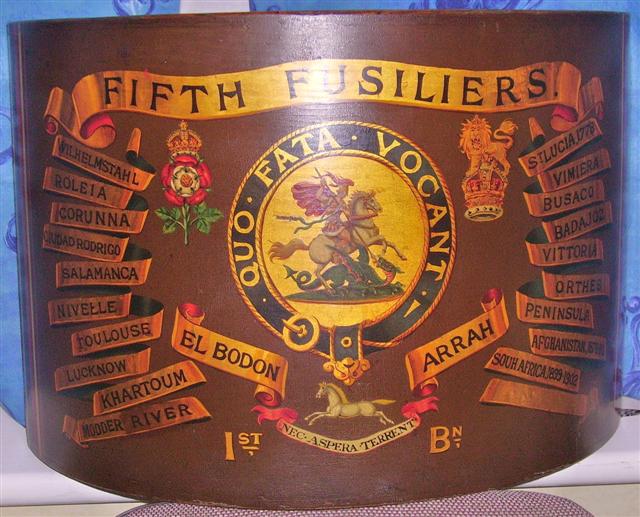
Something a bit unusual - ever wondered what happend to those lovely sets of drums carried by drummers on parade - well it appears that when they reached the end of their life they were often turned into ornaments and here we have a half drum which once belonged to the 1st Battatlion, Northumberland Fusiliers, which was certainly used up to the end of the Great War.
Apologies for the photography and inclusion of the date, but I'm no photo geek.
0 -
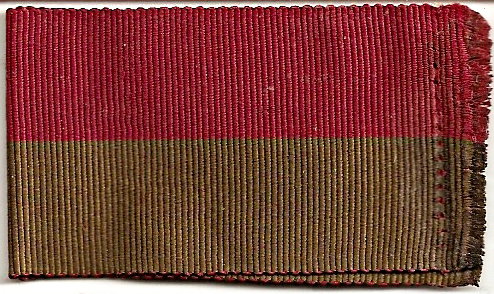
The rare coloured cloth slip identifier of 43rd(6th(City)Bn,RNF)Royal Tank Regiment. Somewhere in the collection I have a photo of a member of 43rd RTR wearing the slip-on, which I'll try and post.
0 -
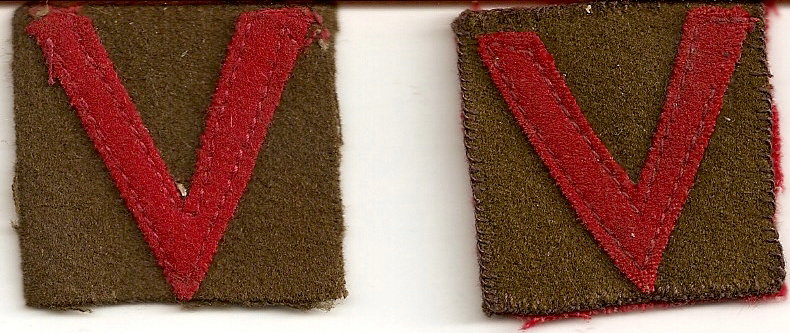
Worn between 1940 & 1950 by officers and other ranks RNF, this was worn on both arms of the battledress uniform and you will notice the inferiority of the scarlet 'V' when compared to that in the last post.
0 -
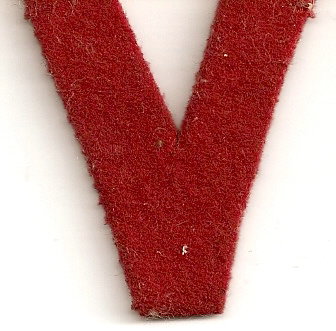
Another rarity. This small cloth scarlet 'V'(5th Foot) came along with some items to the 9th(Service)Bn,NF and therefore believed to be WWI vintage. Although not 100% certain where it was worn, either at the base of the collar of the SD jacket or on the steel helmet cover this is probably an officers badge as the material itself is scarlet melton cloth and so harder wearing than cotton embroided badges or felt cloth. It's larger than the 'V' stitched to a gosling green square and worn by all ranks during WWII.
0 -

Finally the 'scarey-ones' badge, different by the fact that we see the 'gosling green' backing, which as we know was the regiments facing colour.
0 -

One of my favourites the RNF Mountaineering Club badge, a lovely badge and I often wonder exactly how many club members there were?
0 -
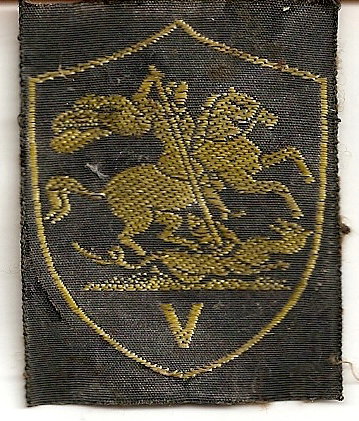
Another alleged sports badge, this one being the size of a match box being yellow silk thread on dark blue.
0 -
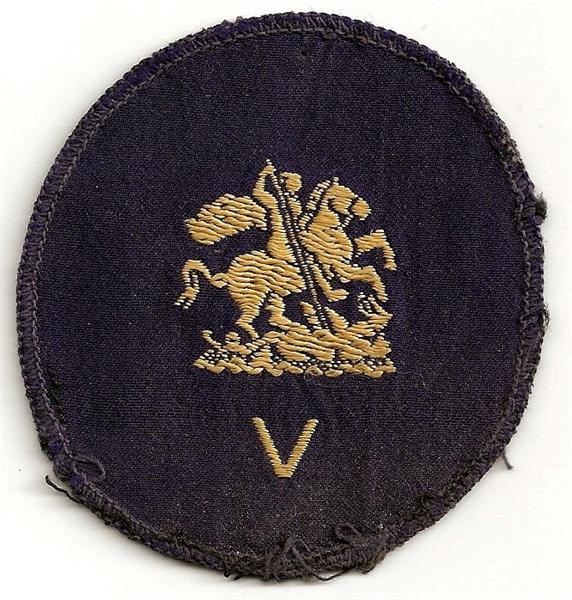
Some of the more unusual RNF badges - a large oval badge allegedly worn with sports kit, the colour being yellow on dark blue.
0




Badges For Some Scary People .... The RSM!
in Great Britain: Militaria: Badges, Uniforms & Equipment
Posted
23rd April - St.George Day and a beautiful illustration of the RQMS of the Northumberland Fusiliers by Brian Fosten, clearly showing his badge of rank. This uniform was worn from 1881 through to c1902, when a new pointed cuff was adopted and facing colours were re-introduced for non-Royal regiments.